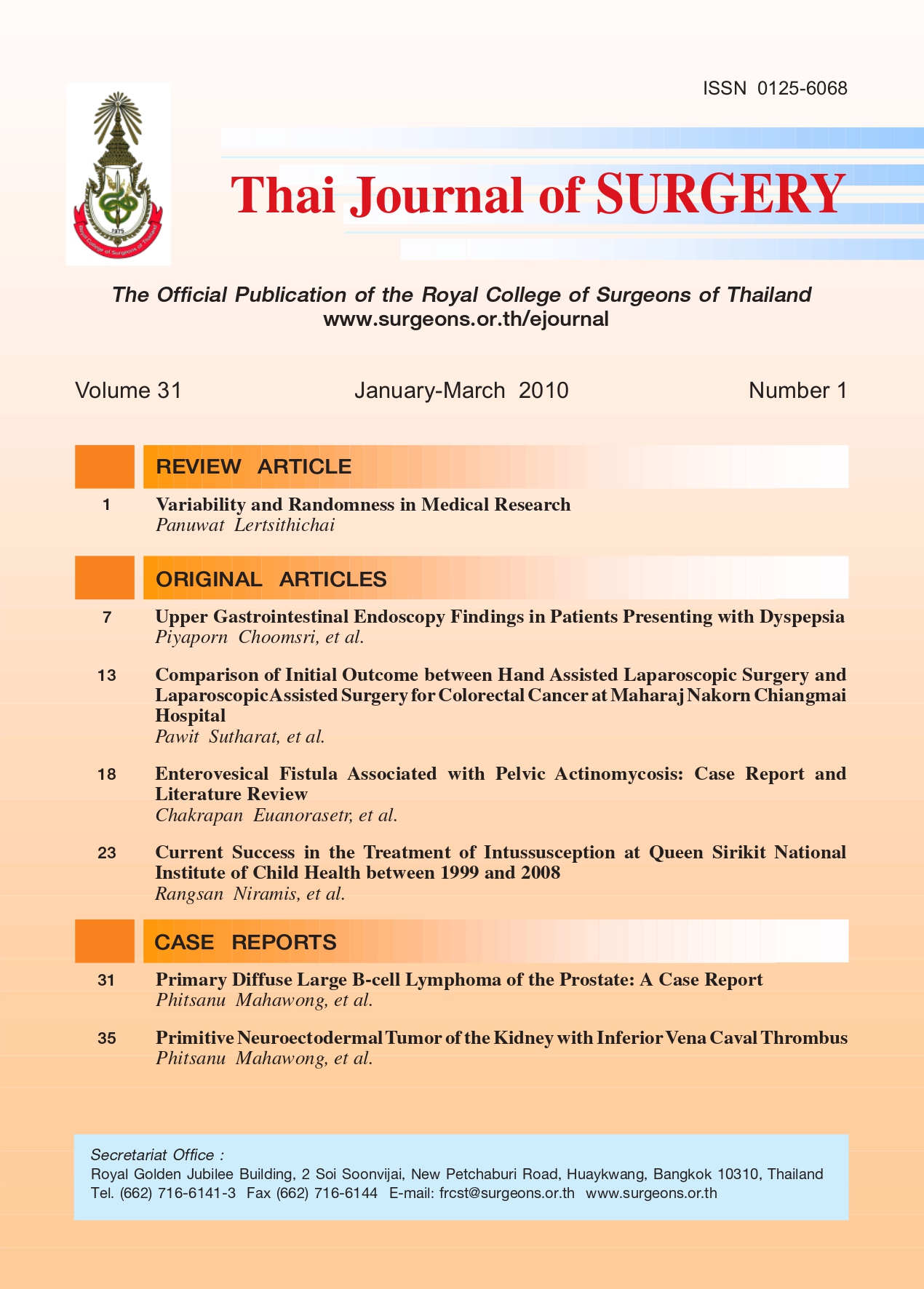Upper Gastrointestinal Endoscopy Findings in Patients Presenting with Dyspepsia
Keywords:
upper gastrointestinal endoscopy, dyspepsia, H. pyloriAbstract
Objective: To determine the prevalence of important upper gastrointestinal (UGI) lesions in patientswith dyspepsia and to determine the associated risk factors.
Methods: A prospective cohort study on dyspeptic patients undergoing UGI endoscopy during the
period between May 2006 and October 2008 was conducted. A questionnaire was administered to all patients
who consented to participate in the study. Endoscopic findings were defined as important if lesions seen were
gastric or duodenal ulcers, moderate to severe gastritis, severe esophagitis, adenomatous polyps or cancer.
Histological examination results were obtained for patients who also underwent endoscopic biopsy.
Results: A total of 291 dyspeptic patients were enrolled. Only 19% (54/291) of patients had important
endoscopic lesions. No clinical findings including age and alarm symptoms were related to important
endoscopic lesions. In 132 patients, 23% (30/132) of the endoscopic biopsies showed evidence of H. pylori
infection. In patients with endoscope biopsy results, H. pylori infection was not associated with important
endoscopic findings.
Conclusion: Dyspeptic patients had a low prevalence of important endoscopic lesions. The presence of
these lesions could not be reliably predicted using clinical data and H. pylori infection status. Empirical antiacid
therapy was recommended as the initial screening therapeutic test prior to endoscopic evaluation for most
patients.
References
N Engl J Med 1998;339:1376-81.
2. Spiller RC. Anorexia, nausea, vomiting, and pain. Br Med J
2001;323:1354-7.
3. Valle PC, Breckan RK, Amin A, et al. “Test, score and scope”:
a selection strategy for safe reduction of upper
gastrointestinal endoscopies in young dyspeptic patients
referred from primary care. Scand J Gastroenterol 2006;41:
161-9.
4. The American Gastroenterological Association. American
Gastroenterological Association medical position statement:
evaluation of dyspepsia. Gastroenterology 2005;129:1753-
55.
5. Tack J, Talley NJ, Camilleri M, Holtman G, Hu PJ, Malagelada
JR, Stanghellini V. Functional gastroduodenal disorders.
Gastroenterology 2006;130:1466-79.
6. Rugge M, Meggio A, Pennelli G, et al. Gastritis staging in
clinical practice: the OLGA staging system. Gut 2007;56:631-
6.
7. Talley NJ, Phung N, Kalantar J. Indigestion: when is it
functional? Br Med J 2001;323:1294-7.
8. Moayyedi P, Shelly S, Deeks JJ, Delaney B, Innes M, Forman
D. Pharmacological interventions for non-ulcer dyspepsia.
Cochrane Database of Syst Rev 2006, Issue 4. Art. No.:
CD001960. DOI: 10.1002/14651858. CD001960.pub3.
9. van Marrewijk C, Mujakovic S, Fransen GAJ, et al. Effect and
cost-effectiveness of step-up versus step-down treatment
with antacids, H2-receptor antagonists, and proto pump
inhibitors in patients with new onset dyspepsia (DIAMOND
study): a primary-care-based randomized controlled trial.
Lancet 2009;373:215-25.
10. Duggan AE, Elliot CA, Miller P, Hawkey CJ, Logan RFA.
Clinical trial: a randomized trial of early endoscopy,
Helicobacter pylori testing and empirical therapy for the
management of dyspepsia in primary care. Aliment
Pharmacol Ther 2008;29:55-68.
11. Ford AC, Moayyedi P, Jarbol DE, Logan RFA, Delaney BC.
Meta-analysis: Helicobacter pylori “test and treat”
compared with empirical acid suppression for managing
dyspepsia. Aliment Pharmacol Ther 2008;28:534-44.
12. Delaney BC, Qume M, Moayyedi P, et al. Helicobacter
pylori test and treat versus proton pump inhibitor in initial
management of dyspepsia in primary care: multicentre
randomized controlled trial (MRC-CUBE trial). Br Med J
2008;336:651-4.
13. Arents NLA, Thijs JC, van Zwet AA, et al. Approach to
treatment of dyspepsia in primary care: a randomized trial
comparing “test-and-treat” with prompt endoscopy. Arch
Intern Med 2003; 163: 1606-12.
14. Peura DA, Haber MM, Hunt B, Atkinson S. Helicobacter
pylori-negative gastritis in erosive gastritis, nonerosive reflux
disease or functional dyspepsia patients. J Clin Gastroenterol
2010;44:180-5.
15. Stabile BE, Smith BR, Weeks DL. H. pylori infection and
surgical disease - part II. Curr Probl Surg 2005;42:796-862.
16. Hartgrink HH, Jansen EPM, van Grieken NCT, van de Velde
CJH. Gastric cancer. Lancet 2009;374:477-90.
17. Vakil N, Moayyedi P, Fennerty MB, Talley NJ. Limited value
of alarm features in the diagnosis of upper gastrointestinal
malignancy: systematic review and meta-analysis.
Gastroenterology 2006;131:390-401.
18. Jones R, Latinovic R, Charlton J, Guilliford MC. Alarm
symptoms in early diagnosis of cancer in primary care:
cohort study using General Practice Research Database. Br
Med J 2007;334:1040-11.
19. Logan RPH, Walker MM. Epidemiology and diagnosis of
Helicobacter pylori infection. Br Med J 2001; 232: 920-2.
20. Stabile BE, Smith BR, Weeks DL. H. pylori infection and
surgical disease - part I. Curr Probl Surg 2005;42:756-89.
Downloads
Published
How to Cite
Issue
Section
License
Articles must be contributed solely to The Thai Journal of Surgery and when published become the property of the Royal College of Surgeons of Thailand. The Royal College of Surgeons of Thailand reserves copyright on all published materials and such materials may not be reproduced in any form without the written permission.



